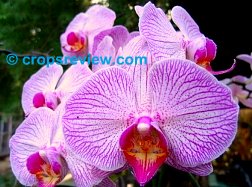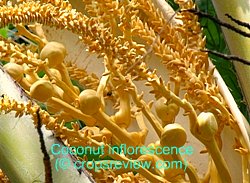Complete familiarity of the flower, flower parts, and their functions is necessary in understanding the subject of reproduction in the angiosperms or flowering plants.
It is particularly important in crop agriculture which includes the development of technology leading to increased yields in terms of flower, fruit, and seed.
The flower is unique to the angiosperms, from which all fruits and seeds develop.
It is the structure of the flower which became the basis of plant classification which Carl Linnaeus formulated and was to become the foundation of the science of plant taxonomy.
A flower is the plant reproductive organ of angiospermous plants which develops within a bud and consists of parts attached to the tip of a short modified stem called receptacle.
It is a determinate, modified shoot having either or both a stamen and pistil, with or without outer whorls of petals and sepals.

In many plants, the same shoot apical meristem that previously produces leaves suddenly terminates leaf production and commences flowering.
In other plants, flowers are directly developed from axillary buds.
Contrary to popular belief, not all flowers or any flower part is showy and attractive, as in the grasses (that is, those plants under the family Poaceae or Gramineae).
The individual flowers are in fact tiny and hidden in the tassels and miniature ears of corn (maize).
The Flower Parts
Typical complete flowers consist of four sets of floral organs: sepals, petals, stamens, and pistils.
Generally, in monocot plants, flower parts occur in threes or multiples of threes and dicots in fours or fives or multiples of fours or fives.
The Floral Envelope
In a complete flower, the outer whorls, called the floral envelope, consist of the calyx and corolla.
The floral envelope encloses (or envelopes) the sexual organs of the flower, the pistil (female), and the stamen (male).
The calyx consists of the entire set of sepals and the corolla an entire set of petals.
The sepals (collectively called calyx) are the outermost organs below the petals which most resemble leaves.
They are generally green and inconspicuous, and they enclose and protect the bud as the flower develops within.
But in some plants, the sepals may be colored and are called petaloid, a structure that is responsible for the flower types called semi-double and double flowers.
The petals (collectively called corolla) are the showy part of most flowers. But in some flowers, the petals are green and are called sepaloid.
In many flowers the petals are large and colorful, making such flowers highly attractive to the man.
These flowers are the main attraction in cut flowers (such as orchids and chrysanthemums) and other floricultural plants.
But in plant development, their main function is to attract pollinators.
They may emit a fragrant aroma, and be supplied with nectar glands that produce a viscous sugary substance.
The sepals and petals are the flower parts that are collectively called the perianth.
But where the sepals and petals are closely alike that they can hardly be differentiated from one another, they are called tepals.
The Essential and Non-Essential Parts of a Flower
The two inner whorls in a complete flower consist of the stamens and the pistils.
As to reproduction, they are considered the fertile and essential parts of a flower because they are directly involved in sexual reproduction, that is, in seed formation.
Consequently, the calyx (sepals) and the corolla (petals) are sterile and are referred to as the non-essential or accessory parts of the flower because they do not directly participate in the process of sexual reproduction.
At most, these flower parts only participate indirectly by attracting pollinators.
But as to a complete flower, all four tissues (sepal, petal, stamen, and pistil) are considered the essential parts because all must be present for a single flower to have a complete structure.
Stated another way, the absence of any of these four organs makes a flower incomplete.
The stamens (collectively called androecium) are considered as the male reproductive part of the flower.
Each stamen typically consists of an anther, which contains the pollen, and thin connecting support called filament.
When the pollen becomes mature, it is usually released through the ruptured anther wall.

Pistils are considered the female reproductive part of the flower.
Each pistil typically consists of three flower parts: an enlarged basal ovary, one or more styles, and one or more stigmas (sing. stigma). In some flowers, the style may be absent.
A pistil may consist of one or more ovule-bearing units called carpel.
It may be equivalent to a single carpel, in which case it is called a simple pistil, otherwise, it is composed of two or more fused carpels in which case it is called a compound pistil.
Carpels are collectively called gynoecium.
The stigma is an enlarged tip of the pistil that serves as a “landing pad” to receive the pollen in the process of pollination.
This part of the flower may be supported by a slender stalk (the style) which is connected to an enlarged base (the ovary) that contains one or more ovules.
After pollination and double fertilization, the ovary develops into an outer fruit and the ovule into a seed.
Flower Arrangement
The flowers are arranged in different ways on the same plant.
They may appear singly (solitary flower) or in clusters (inflorescence).
Solitary flowers are either sessile or pedicelled.
Sessile flowers are without a supporting stalk; pedicelled flowers are supported by a stalk.
A stalk that supports a cluster of flowers is called peduncle, and the individual stalk of a solitary flower or each flower in an inflorescence is called a pedicel.
Flowers and inflorescences are usually supplied with bracts and bracteoles in various sizes, often resembling leaves.
Bracts are generally found at the base of each branch and branchlet of the inflorescence; the bracteoles are at the base of the pedicels of the flowers.
In grasses, the inflorescence consists of spikelets, or small spikes, each one of which contains one to several flowers and associated bracts.
Each flower is surrounded by a lemma and palea, the most visible structures of what is commonly referred to as the rice hull.
